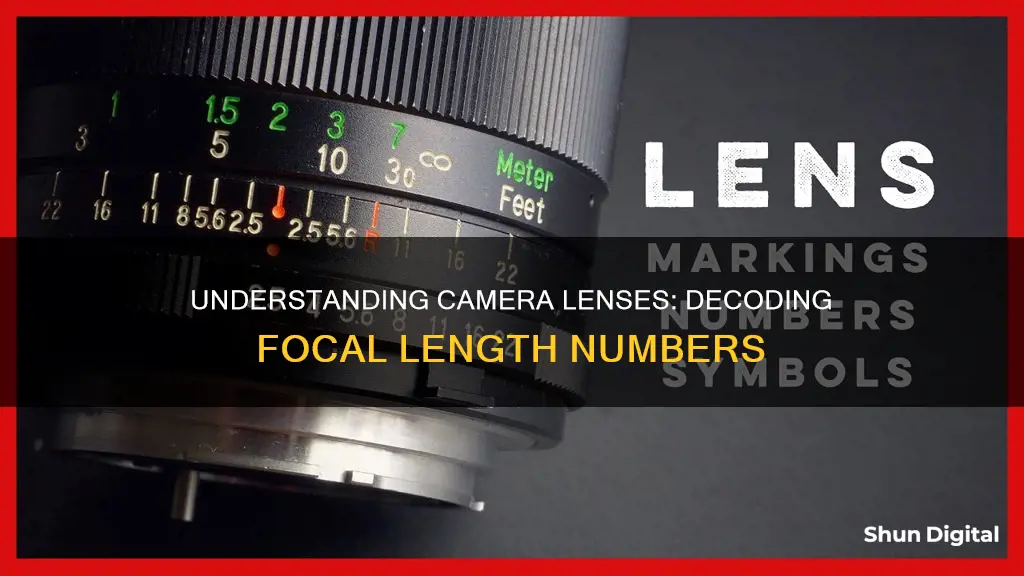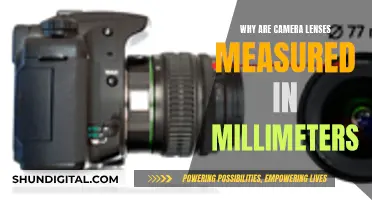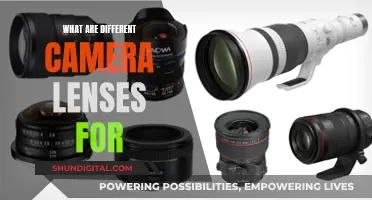
Camera lenses are inscribed with basic specifications that help photographers understand what the lens is capable of and what types of photography it is good for. The numbers on a camera lens indicate the focal length, maximum aperture (f-stop setting), and filter size. For example, the numbers 18-55mm on a lens indicate that 18mm is the shortest focal length and 55mm is the longest focal length. The lower the focal length, the more you will see in your image (wider view). The higher the focal length, the less you will see in your image (more zoomed in). The letter F on a lens typically refers to the aperture or f-stop, which relates to the speed of the lens. The size of the aperture is denoted by an f followed by a / and then a number, e.g. f/4.5. A smaller f-stop number signifies a wider aperture, while a larger number signifies a narrower aperture.
| Characteristics | Values |
|---|---|
| Focal length | The focal length of a lens is measured in millimetres (mm) and describes the field of view. The smaller the number, the wider the field of view. |
| Aperture | The aperture is measured using f-numbers or f-stops. Smaller f-numbers indicate a wider aperture, while larger numbers indicate a narrower aperture. |
| Focal range | The focal range of a lens is given as a pair of numbers, indicating the widest and most zoomed angles. |
| Maximum aperture | The maximum aperture is the widest aperture setting and is marked on the lens. |
| Minimum aperture | The minimum aperture is the smallest aperture setting. |
| Minimum focusing distance | The minimum distance from the lens that can be brought into focus, measured in meters and feet. |
| Lens diameter | The diameter of the lens, measured in millimetres. |
| Lens mount | The mount system the lens is compatible with, denoted by a series of letters. |
What You'll Learn

Focal length: the field of view of the lens
Focal length is a fundamental parameter of a lens that describes how strongly it focuses or diverges light. The focal length of a lens defines its field of view (FOV), which is the maximum area of a scene that a camera can capture. The FOV is represented in degrees and can be calculated using the formula:
AFOV = 2 x tan^-1 (H / 2f)
Where:
- AFOV is the angular field of view
- H is the width of the sensor
- F is the focal length of the lens
The shorter the focal length, the wider the AFOV, and vice versa. This relationship is important to understand when choosing a lens for your camera, as it determines how much of a scene will be captured in the frame.
A lens with a focal length of 50mm is considered a standard angle, similar to the human eye. A lens with a 20mm focal length provides a wide-angle view, while a 100mm focal length gives a tighter, more magnified view.
When looking through your camera's viewfinder, the lower the focal length (smaller number), the more you will see in your image (wider view). Conversely, a higher focal length (larger number) will result in a more zoomed-in image. For example, an 18-55mm lens can be used at its widest angle (18mm) or most zoomed (55mm), or anywhere in between.
It's worth noting that the focal length of a lens is usually measured in millimeters (mm), and this unit is typically denoted after the number, e.g. 18mm or 50mm.
The Magic of Camera Filters: Enhancing Your Lens's Vision
You may want to see also

Aperture: how wide the lens opens
Aperture is one of the three pillars of photography, alongside shutter speed and ISO. It is the opening in a lens through which light passes to enter the camera. The wider the aperture, the more light that enters the camera. This is important because it allows you to control exposure.
The aperture is controlled by the diaphragm, which functions much like the iris of the eye. The diaphragm controls the effective diameter of the lens opening (called the pupil in the eye). Reducing the aperture size (increasing the f-number) provides less light to the sensor and increases the depth of field.
The aperture is measured in an f-stop number. The lower the f-stop number, the more open the aperture is, and therefore more light enters your camera. The higher the f-stop number, the smaller the aperture, and less light enters your camera.
The f-stop number is calculated by dividing the focal length of the lens by the diameter of the aperture. For example, if a lens has a focal length of 50mm and an aperture diameter of 25mm, the f-stop would be 2 (50/25) or f/2.
Aperture is notated on the lens as a fraction, with the f-stop as the numerator and 1 as the denominator. For example, f/2.8 is a larger aperture than f/16. This can be confusing for beginners, as it goes against basic intuition. However, there is a simple explanation: aperture is a fraction. When dealing with an f-stop of f/16, for example, you can think of it as the fraction 1/16, which is clearly much smaller than the fraction 1/4.
The size of the aperture (the f-stop number) also determines the shutter speed that is needed to achieve the correct exposure. A small aperture (large f-stop number) will require a longer shutter speed, while a large aperture (small f-stop number) will require a shorter shutter speed.
Aperture is a crucial setting in photography and is possibly the single most important setting. It affects several different parts of your photo, from brightness and depth of field to sharpness and bokeh (the quality of out-of-focus highlights in the image).
The Evolution of Point-and-Shoot Cameras: Multiple Lenses, Many Possibilities
You may want to see also

F-stop: the lens's speed
The "F" in "F-stop" stands for "f-number", which relates to the "speed" of your lens. The f-stop scale denotes the lens's aperture—the size of the opening in your lens when you take a photo. The size of the aperture is denoted by an "f" followed by a "/" and then a number, like this: f/4.5.
A smaller f-stop number signifies a wider aperture, while a larger number signifies a narrower aperture. For example, f/2 is wide, and f/22 is narrow. The maximum aperture—the widest aperture—is always marked on the lens, telling you if the lens is "fast" or "slow". Faster lenses with wider apertures let in more light and give you better depth-of-field control, but they tend to be more expensive.
The first number in a lens reading is the f-stop. Some manufacturers express the f-stop as a ratio (1:##). A lens reading of 1.8/55 or 1:1.8 means the lens's maximum aperture is f/1.8.
Telephoto lenses often have a range of numbers on either side of the slash (## – ## / ## – ## or 1: ## – ##). This is because some zoom lenses have a variable max aperture—the maximum aperture is different depending on the focal length being used. For example, a 70-300mm f/4.5-6.3 lens has a maximum aperture of f/4.5 at 70mm. But when you zoom in to 300mm, the aperture is limited to f/6.3.
If a zoom lens only displays one f-stop number, like f/2.8, the maximum aperture is constant throughout the zoom range.
Lenses: The True Power Behind Photography
You may want to see also

Lens mount system: which cameras the lens is compatible with
A lens mount is a mechanical device that attaches a lens to a camera body. It is an interface between a camera body and a lens. Lens mounts are also used to connect optical components in instrumentation that may not involve a camera, such as the modular components used in optical laboratory prototyping.
Lens mounts are usually differentiated by their throat size, inner and outer diameters, and flange distance. The throat size of a lens mount is the inner diameter of a mount, minus the tabs that are used to mount lenses. The inner diameter of a lens mount represents the size of the lens opening, ignoring the tabs on the mount. The outer diameter of a lens mount is the full diameter of the bayonet mount, which in most cameras represents the end of the metal mount. Flange distance, also known as "flange focal distance", is the distance between the mounting flange and the film/sensor plane.
Different camera brands have different lens mount systems. Here is a list of some of the most common lens mount systems and the camera brands they are compatible with:
- DSLR cameras: EF, EF-S (Canon); AF, AF-S (Nikon)
- Mirrorless cameras: RF, RF-S (Canon); Z, DX Z (Nikon); FE (Sony); RF (Canon); Z (Nikon); X (Fujifilm); G (Micro Four Thirds)
It is important to note that lens mounts of competing manufacturers (such as Sony, Nikon, and Canon) are usually incompatible with each other. Therefore, when purchasing a lens, it is crucial to ensure that the lens mount matches your camera brand and model.
Understanding Camera and Lens Lifespan by Shot Count
You may want to see also

Lens diameter: the size of the outside circle of the lens
The symbol that looks like a circle with a line through it (Ø) indicates the lens's diameter. This is the measurement, in millimetres, of the outside circle of your lens. For instance, Ø72 means that your lens has a diameter of 72 millimetres.
This measurement is important if you need to buy a new lens cap. It is also essential if you want to use lens filters, as screw-on filters come in different sizes. You will need to match the filter size to the lens diameter.
The diameter of the lens is usually displayed after the Ø symbol. For example, a Sigma lens with a 67mm diameter would be displayed as Ø67mm.
The Creative Power of Normal and Wide Angle Lenses
You may want to see also
Frequently asked questions
The numbers on a camera lens refer to the focal length, aperture range, and lens diameter.
Focal length is what you see when you look through your camera viewfinder. The lower the focal length (smaller number), the more you will see in your image (wider view). The higher the focal length (larger number), the less you will see in your image (more zoomed in).
Aperture is how big the opening in your lens is when you take a picture. The size of the opening is measured in f-stops. The smaller the number, the wider the opening and therefore the more light gets into your camera.
The symbol that looks like a circle with a line through it (Ø) tells us the diameter of the lens. This is the measurement, in millimetres, around the outside circle of your lens. This is important if you need a new lens cap or want to use lens filters.
Zoom lenses have a variable focal length with the limits of the range in the title of the lens. Prime lenses have a fixed focal length, meaning there is no zoom function.







